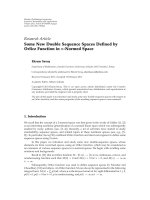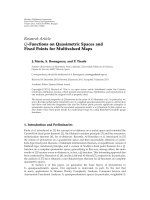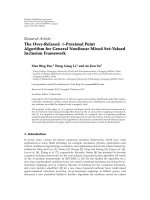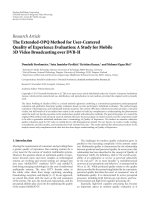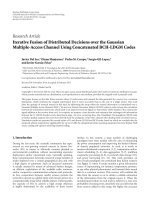Báo cáo hóa học: " Research Article The Methods of Hilbert Spaces and Structure of the Fixed-Point Set of Lipschitzian Mapping" docx
Bạn đang xem bản rút gọn của tài liệu. Xem và tải ngay bản đầy đủ của tài liệu tại đây (497.9 KB, 12 trang )
Hindawi Publishing Corporation
Fixed Point Theory and Applications
Volume 2009, Article ID 586487, 12 pages
doi:10.1155/2009/586487
Research Article
The Methods of Hilbert Spaces and Structure of
the Fixed-Point Set of Lipschitzian Mapping
Jarosław G
´
ornicki
Department of Mathematics, Rzesz
´
ow University of Technology, P.O. Box 85, 35-595 Rzesz
´
ow, Poland
Correspondence should be addressed to Jarosław G
´
ornicki,
Received 16 May 2009; Accepted 25 August 2009
Recommended by William A. Kirk
The purpose of this paper is to prove, by asymptotic center techniques and the methods of Hilbert
spaces, the following theorem. Let H be a Hilbert space, let C be a nonempty bounded closed
convex subset of H, and let M a
n,k
n,k≥1
be a strongly ergodic matrix. If T : C → C is a
lipschitzian mapping such that lim inf
n →∞
inf
m0,1,
∞
k1
a
n,k
·T
km
2
< 2, then the set of fixed
points FixT {x ∈ C : Tx x} is a retract of C. This result extends and improves the
corresponding results of 7, Corollary 9 and 8, Corollary 1.
Copyright q 2009 Jarosław G
´
ornicki. This is an open access article distributed under the Creative
Commons Attribution License, which permits unrestricted use, distribution, and reproduction in
any medium, provided the original work is properly cited.
1. Introduction
Let E be a Banach space and let C be a nonempty bounded closed convex subset of E.Wesay
that a mapping T : C → C is nonexpansive if
Tx − Ty
x − y
for every x, y ∈ C. 1.1
The result of Bruck 1 asserts that if a nonexpansive mapping T : C → C has a fixed
point in every nonempty closed convex subset of C which is invariant under T and if C is
convex and weakly compact, then Fix T {x ∈ C : Tx x}, the set of fixed points, is
nonexpansive retract of C i.e., there exists a nonexpansive mapping R : C → Fix T such that
R
|Fix T
I. A few years ago, the Bruck results were extended by T. Dom
´
ınguez Benavides
and Lorenzo Ram
´
ırez 2 to the case of asymptotically nonexpansive mappings if the space E
was sufficiently regular.
On the other hand it is known that, the set of fixed points of k-lipschitzian mapping
can be very irregular for any k>1.
2 Fixed Point Theory and Applications
Example 1.1 Goebel 3, 4.LetF be a nonempty closed subset of C.Fixz ∈ F,0<ε<1and
put
Tx x ε · dist
x, F
·
z − x
,x∈ C. 1.2
It is not difficult to see that Fix T F and the Lipschitz constant of T tends to 1 if ε ↓ 0.
For more information on the structure of fixed point sets see 4, 5 and references
therein.
In 1973, Goebel and Kirk 3 introduced the class of uniformly k-lipschitzian
mappings, recall that a mapping T : C → C is uniformly k-lipschitzian, k 1, if
T
n
x − T
n
y
k
x − y
for every x, y ∈ C, n ∈ N, 1.3
and proved the following theorem.
Theorem 1.2. Let E be a uniformly convex Banach space with modulus of convexity δ
E
and let C be
a nonempty bounded closed convex subset of E. Suppose that T : C → C is uniformly k-lipschitzian
and
k
1 − δ
E
1
k
< 1. 1.4
Then T has a fixed point in C. Note that in a Hilbert space, k<1/2
√
5.
Recently Se¸dłak and Wi
´
snicki 6 proved that under the assumptions of Theorem 1.2,
Fix T is not only connected but even a retract of C, and next the author proved the following
theorem 7, Corollary 9.
Theorem 1.3. Let H be a Hilbert space, C a nonempty bounded closed convex subset of H, and
T : C → C a uniformly k-lipschitzian mapping with k<
√
2.ThenT has a fixed point in C and
Fix T is a retract of C.
In this paper we shall continue this work. Precisely, by means of techniques of
asymptotic centers and the methods of Hilbert spaces, we establish some result on the
structure of fixed point sets for mappings with lipschitzian iterates in a Hilbert space. The
class of mappings with lipschitzian iterates is importantly greater than the class of uniformly
lipschitzian mappings; see 8, Example 1.
2. Asymptotic Center
Denote by T the Lipschitz norm of T:
T
sup
Tx − Ty
x − y
: x, y ∈ C, x
/
y
. 2.1
Fixed Point Theory and Applications 3
Lifshitz 9 significantly extended Goebel and Kirk’s result and found an example of a fixed
point free uniformly π/2−lipschitzian mapping which leaves invariant a bounded closed
convex subset of l
2
. The validity of Lifshitz’s Theorem in a Hilbert space for
√
2 k<π/2
remains open.
A more general approach was proposed by the present author using the methods of
Hilbert spaces, asymptotic techniques, and strongly ergodic matrix. We recall that a matrix
M a
n,k
n,k1
is called strongly ergodic if
i for all n, k a
n,k
0,
ii for all k lim
n →∞
a
n,k
0,
iii for all n
∞
k1
a
n,k
1,
iv lim
n →∞
∞
k1
|a
n,k1
− a
n,k
| 0.
Then we have the following theorem.
Theorem 2.1 see 8. Let C be a nonempty bounded closed convex subset of a Hilbert space and let
M a
n,k
n,k1
be a strongly ergodic matrix. If T : C → C is a mapping such that
g lim inf
n →∞
inf
m0,1,
∞
k1
a
n,k
·
T
km
2
< 2,
2.2
then T has a fixed point in C.
This result generalizes Lifshitz’s Theorem in case of a Hilbert space and shows that
the theorem admits certain perturbations in the behavior of the norm of successive iterations
in infinite sets; see 8, Example 1.
Let E be a Banach space. Recall that the modulus of convexity δ
E
is the function δ
E
:
0, 2 → 0, 1 defined by
δ
E
ε
inf
1 −
1
2
x y
:
x
1,
y
1,
x − y
ε
2.3
and uniform convexity means δ
E
ε > 0forε>0. A Hilbert space H is uniformly convex. This
fact is a direct consequence of parallelogram identity.
Now we prove some version of Se¸dłak and Wi
´
snicki’s result 6, Lemma 2.1.LetC
be a nonempty bounded closed convex subset of a real Hilbert space H,letM a
n,k
n,k1
be a strongly ergodix matrix, and let T : C → C be a mapping such that T
k
1 for all
k 1, 2, ,and
lim sup
n →∞
∞
k1
a
n,k
·
T
k
2
B<∞.
2.4
4 Fixed Point Theory and Applications
Let x, y ∈ C we use
r
y,
T
k
x
lim sup
n →∞
∞
k1
a
n,k
·
y − T
k
x
2
,
r
C,
T
k
x
inf
y∈C
r
y,
T
k
x
2.5
to denote the asymptotic radius of {T
k
x} at y and the asymptotic radius of {T
k
x} in C,
respectively. It is well known in a Hilbert space 8 that the asymptotic center of {T
k
x} in
C:
A
C,
T
k
x
y ∈ C : r
y,
T
k
x
r
C,
T
k
x
2.6
is a singleton.
Let A : C → C denote a mapping which associates with a given x ∈ C aunique
z ∈ AC, {T
k
x},thatis,z Ax. The following Lemma is a crucial tool to prove Theorem 4.1.
Lemma 2.2. Let H be a Hilbert space and let C be a nonempty bounded closed convex subset of H.
Then the mapping A : C → C is continuous.
Proof. On the contrary, suppose that there exists x
0
∈ C and ε
0
> 0 such that for all η>0 there
exists x
1
∈ C such that x
1
− x
0
<ηand z
1
− z
0
ε
0
, where {z
0
} AC, {T
k
x
0
}, {z
1
}
AC, {T
k
x
1
}.
Fix η>0 and take x
1
∈ C such that
x
1
− x
0
<η,
z
1
− z
0
ε
0
. 2.7
Let R
0
rC, {T
k
x
0
}, R
1
rC, {T
k
x
1
} and R lim
n →∞
∞
k1
a
n,k
·z
1
− T
k
x
0
2
.Noticethat
R
0
<R. 2.8
Choose ε>0. Then
⎧
⎪
⎪
⎪
⎨
⎪
⎪
⎪
⎩
z
1
− T
k
x
0
<
√
R ε,
z
0
− T
k
x
0
<
R
0
ε<
√
R ε,
z
0
− z
1
≥ ε
0
2.9
for all but fi nitely many k.
If, for example, z
1
− T
k
x
0
√
R ε for all everyone k, then
z
1
− T
k
x
0
2
R ε.
2.10
Fixed Point Theory and Applications 5
Multiplying both sides of this inequality for fixed k by suitable element of the matrix M
and summing up such obtained inequalities for k 1, we have for n 1, 2, ,
∞
k1
a
n,k
·
z
1
− T
k
x
0
2
R ε.
2.11
Taking the limit superior as n →∞on each side, we get
R lim sup
n →∞
∞
k1
a
n,k
·
z
1
− T
k
x
0
2
R ε>R,
2.12
which is contradiction.
It follows by 2.9 and the properties of δ
H
that
T
k
x
0
−
z
1
z
0
2
1 − δ
H
ε
0
√
R ε
√
R ε,
T
k
x
0
−
z
1
z
0
2
2
1 − δ
H
ε
0
√
R ε
2
R ε
.
2.13
Multiplying both sides of this inequality by suitable elements of the matrix M and summing
up such obtained inequalities for k 1, taking the limit superior as n →∞on each side, we
get
R
0
< lim sup
n →∞
∞
k1
a
n,k
·
T
k
x
0
−
z
1
z
0
2
2
1 − δ
H
ε
0
√
R ε
2
R ε
.
2.14
Moreover,
T
k
x
0
− z
1
2
T
k
x
0
− T
k
x
1
T
k
x
1
− z
1
2
T
k
x
0
− T
k
x
1
2
2
T
k
x
0
− T
k
x
1
·
T
k
x
1
− z
1
T
k
x
1
− z
1
2
T
k
2
·
x
0
− x
1
2
2
T
k
·
x
0
− x
1
·
T
k
x
1
− z
1
T
k
x
1
− z
1
2
T
k
2
2
T
k
·
x
0
− x
1
· diam C
T
k
x
1
− z
1
2
3
T
k
2
· diam C ·
x
0
− x
1
T
k
x
1
− z
1
2
.
2.15
6 Fixed Point Theory and Applications
Multiplying both sides of this inequality by suitable elements of the matrix M and summing
up such obtained inequalities for k 1, taking the limit superior as n →∞on each side, we
get
R lim sup
n →∞
∞
k1
a
n,k
·
T
k
x
0
− z
1
2
3 · diam C ·
x
0
− x
1
· lim sup
n →∞
∞
k1
a
n,k
·
T
k
2
lim sup
n →∞
∞
k1
a
n,k
·
T
k
x
1
− z
1
2
3 · B · diam C · η R
1
ε.
2.16
Similarly,
R
1
< lim sup
n →∞
∞
k1
a
n,k
·
T
k
x
1
− z
0
2
3 · diam C ·
x
1
− x
0
· lim sup
n →∞
∞
k1
a
n,k
·
T
k
2
lim sup
n →∞
∞
k1
a
n,k
·
T
k
x
0
− z
0
2
3 · B · diam C · η R
0
ε.
2.17
From 2.16 and 2.17, we have
R 3 · B · diam C · η R
1
ε<6 · B · diam C · η 2 · ε R
0
. 2.18
If R
0
0, then from 2.18 it follows R 0. This is contradiction with 2.8.IfR
0
> 0, then
combining 2.18 with 2.14 and applying the monotonicity of δ
H
,weobtain
R
0
<
1 − δ
H
ε
0
6 · B · diam C · η 3 · ε R
0
2
6 · B · diam C · η 3 · ε R
0
.
2.19
Letting η, ε ↓ 0 and using the continuity of δ
H
, we conclude that
1
1 − δ
H
ε
0
R
0
2
< 1.
2.20
This contradiction proves the continuity of mapping A.
Fixed Point Theory and Applications 7
3. The Methods of Hilbert Spaces
Let M, T be as above. We define functionals
d
u
lim sup
n →∞
∞
k1
a
n,k
·
u − T
k
u
2
,
r
x
lim sup
n →∞
∞
k1
a
n,k
·
x − T
k
u
2
,
3.1
where u, x ∈ C.Letz in C be an asymptotic center of {T
k
u}
k1
with respect to r· and C,
which minimizes the functional rx over x in C for fix u ∈ C.
Lemma 3.1. One has rz du.
Proof. It is consequence of the above definitions.
Lemma 3.2. One has z − u 2
du.
Proof. For any k ∈ N, we have
z − u
2
2
z − T
k
u
2
T
k
u − u
2
−
z u − 2T
k
u
2
2
z − T
k
u
2
2
T
k
u − u
2
.
3.2
Multiplying both sides of this inequality by suitable elements of the matrix M and summing
up such obtained inequalities for k 1, taking the limit superior as n →∞on each side, we
get
z − u
2
2 lim sup
n →∞
∞
k1
a
n,k
·
z − T
k
u
2
2 lim sup
n →∞
∞
k1
a
n,k
T
k
u − u
2
2
r
z
d
u
4d
u
.
3.3
Lemma 3.3. One has rT
s
z T
s
2
· rz for all s ∈ N.
Proof. Fix s ∈ N, then we have
∞
k1
a
n,k
T
s
z − T
k
u
2
s
k1
a
n,k
T
s
z − T
k
u
2
T
s
2
·
∞
ks1
a
n,k
z − T
k−s
u
2
s
k1
a
n,k
T
s
z − T
k
u
2
T
s
2
·
∞
k1
a
n,k
z − T
k−s
u
2
−
s
k1
a
n,k
z − T
k−s
u
2
.
3.4
8 Fixed Point Theory and Applications
Since the matrix M is strongly ergodic,
s
k1
a
n,k
T
s
z − T
k
u
2
−→ 0,
s
k1
a
n,k
z − T
k−s
u
2
−→ 0,
3.5
as n →∞, we get thesis.
Lemma 3.4. One has rzz − x
2
rx for every x ∈ C.
Proof. For x ∈ C and 0 <t<1, we have
tx 1 − tz − T
k
u
2
t
x − T
k
u
2
1 − t
z − T
k
u
2
− t
1 − t
x − z
2
.
3.6
Multiplying both sides of this inequality by suitable elements of the matrix M and summing
up such obtained inequalities for k 1, taking the limit superior as n →∞on each side, we
get
lim sup
n →∞
∞
k−1
a
n,k
tx 1 − tz − T
k
u
2
t · lim sup
n →∞
∞
k1
a
n,k
x − T
k
u
2
1 − t
· lim sup
n →∞
∞
k1
a
n,k
z − T
k
u
2
− t
1 − t
x − z
2
.
3.7
Since rz rtx 1 − tz,weobtain
r
z
t · r
x
1 − t
· r
z
− t
1 − t
x − z
2
,
r
z
r
x
−
1 − t
x − z
2
.
3.8
Taking t ↓ 0
,weget,rzz − x
2
rx.
4. Main Result
We are now in position to prove our main result.
Theorem 4.1. Let C be a nonempty bounded closed convex subset of a Hilbert space and let M
a
n,k
n,k1
be a strongly ergodic matrix. If T : C → C is a mapping such that
g lim inf
n →∞
inf
m0,1,
∞
k1
a
n,k
·
T
km
2
< 2,
4.1
then Fix T {x ∈ C : Tx x} is a retract of C.
Fixed Point Theory and Applications 9
Proof. Let {n
i
} and {m
i
} be sequences of natural numbers such that
g lim
i →∞
∞
k1
a
n
i
,k
·
T
km
i
2
< 2.
4.2
By Theorem 2.1,Fix T
/
∅. For any x ∈ C we can inductively define a sequence {z
j
} in the
following manner: z
1
is the unique point in C that minimizes the functional
lim sup
i →∞
∞
k1
a
n
i
,k
·
y − T
km
i
x
2
4.3
over y ∈ C, and z
j1
is the unique point in C that minimizes the functional
lim sup
i →∞
∞
k1
a
n
i
,k
·
y − T
km
i
z
j
2
4.4
over y ∈ C,thatis,z
j
A
j
x, j 1, 2, First we prove the following inequality:
d
z
g − 1
d
u
,
4.5
where
d
u
lim sup
i →∞
∞
k1
u − T
km
i
u
2
,
4.6
and z is the asymptotic center in C which minimizes the functional
r
x
lim sup
i →∞
∞
k1
x − T
km
i
u
2
4.7
over x in C.
In fact, we put in Lemma 3.4 x T
p
z. Then by Lemma 3.3,weget
r
z
z − T
p
z
2
r
T
p
z
T
p
2
· r
z
,
z − T
p
z
2
T
p
2
− 1
· r
z
.
4.8
For p m k
i
we have
z − T
km
i
z
2
T
km
i
2
− 1
· r
z
, 4.9
10 Fixed Point Theory and Applications
and hence
d
z
lim sup
i →∞
∞
k1
a
n
i
,k
·
z − T
km
i
z
2
lim
i →∞
∞
k1
a
n
i
,k
·
T
km
i
2
− 1
· r
z
g − 1
· r
z
by Lemma 3.1
g − 1
·
d
u
.
4.10
Next by Lemma 3.2 and inequality 4.5, we have
z
j1
− z
j
A
j1
x − A
j
x
2
g − 1
j
d
x
2 · α
j
·
diam C,
4.11
where α
g − 1 < 1forx ∈ C, j 1, 2, Thus
sup
x∈C
A
p
x − A
j
x
α
j
1 − α
· 2 ·
diam C
−→ 0ifp, j −→ ∞,
4.12
which implies that the sequence {A
j
x} converges uniformly t o a function
Rx lim
j →∞
A
j
x, x ∈ C.
4.13
It follows from Lemma 2.2 that R : C → C is continuous. Moreover,
Rx − T
km
i
Rx
2
2
Rx − A
j
x
2
A
j
x − T
km
i
Rx
2
−
Rx T
km
i
Rx − 2A
j
x
2
2
Rx − A
j
x
2
2
A
j
x − T
km
i
Rx
2
2
Rx − A
j
x
2
2
2
A
j
x − T
km
i
A
j
x
2
2
T
km
i
A
j
x − T
km
i
Rx
2
2 4
T
km
i
2
·
Rx − A
j
x
2
4
A
j
x − T
km
i
A
j
x
2
.
4.14
Fixed Point Theory and Applications 11
Multiplying both sides of this inequalities by suitable elements of the matrix M and summing
up such obtained inequalities for k 1, taking the limit superior as i →∞on each side, we
get
d
Rx
lim sup
i →∞
∞
k1
a
n
i
,k
·
Rx − T
km
i
Rx
2
2 4 lim
i →∞
∞
k1
a
n
i
,k
·
T
km
i
2
Rx − A
j
x
2
4 lim sup
i →∞
∞
k1
a
n
i
,k
·
A
j
x − T
km
i
A
j
x
2
2 4g
Rx − A
j
x
2
4
d
A
j
x
by
4.5
2 4g
Rx − A
j
x
2
4
g − 1
j
·
d
x
→ 0ifj →∞.
4.15
Thus,
dRx0. This implies that Rx TRx;see8 for details. Thus Rx TRx for every
x ∈ C and R is a retraction of C onto Fix T.
If M a
n,k
n,k1
is the Cesaro matrix, that is, for n 1, 2, ,
a
n,k
⎧
⎨
⎩
1
n
for k 1, 2, ,n,
0fork n 1,
4.16
then we have the following corollary.
Corollary 4.2. Let C be a nonempty bounded closed convex subset of a Hilbert space. If T : C → C
is a mapping such that
g lim inf
n →∞
inf
m0,1,
1
n
n
k1
T
km
2
< 2,
4.17
then Fix T {x ∈ C : Tx x} is a retract of C.
References
1 R. E. Bruck Jr., “Properties of fixed-point sets of nonexpansive mappings in Banach spaces,”
Transactions of the American Mathematical Society, vol. 179, pp. 251–262, 1973.
2 T. Dom
´
ınguez-Benavides and P. Lorenzo Ram
´
ırez, “Structure of the fixed point set and common fixed
points of asymptotically nonexpansive mappings,” Proceedings of the American Mathematical Society, vol.
129, no. 12, pp. 3549–3557, 2001.
3 K. Goebel and W. A. Kirk, “A fixed point theorem for transformations whose iterates have uniform
Lipschitz constant,” Studia Mathematica, vol. 47, pp. 135–140, 1973.
4 K. Goebel and W. A. Kirk, “Classical theory of nonexpansive mappings,” in Handbook of Metric Fixed
Point Theory, W. A. Kirk and B. Sims, Eds., pp. 49–91, Kluwer Academic Publishers, Dordrecht, The
Netherlands, 2001.
12 Fixed Point Theory and Applications
5 R. E. Bruck, “Asymptotic behavior of nonexpansive mappings,” in Fixed Points and Nonexpansive
Mappings, R. C. Sine, Ed., vol. 18 of Contemp. Math., pp. 1–47, American Mathematical Society,
Providence, RI, USA, 1983.
6 E. Se¸dłak and A. Wi
´
snicki, “On the structure of fixed-point sets of uniformly Lipschitzian mappings,”
Topological Methods in Nonlinear Analysis, vol. 30, no. 2, pp. 345–350, 2007.
7 J. G
´
ornicki, “Remarks on the structure of the fixed-point sets of uniformly Lipschitzian mappings in
uniformly convex Banach spaces,” Journal of Mathematical Analysis and Applications, vol. 355, no. 1, pp.
303–310, 2009.
8 J. G
´
ornicki, “A remark on fixed point theorems for Lipschitzian mappings,” Journal of Mathematical
Analysis and Applications, vol. 183, no. 3, pp. 495–508, 1994.
9 E. A. Lifshitz, “A fixed point theorem for operators in strongly convex spaces,” Voronezhsk
˘
ı
Gosudarstvenny
˘
ı Universitet imeni Leninskogo Komsomola. Trudy Matematicheskogo Fakul’teta, vol. 16, pp.
23–28, 1975 Russian.

